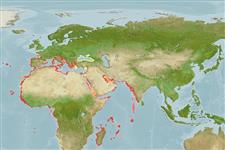Preferred temperature (Réf.
123201): 16.2 - 29, mean 26.3 °C (based on 478 cells).
Phylogenetic diversity index (Réf.
82804): PD
50 = 1.0000 [Uniqueness, from 0.5 = low to 2.0 = high].
Bayesian length-weight: a=0.01380 (0.01022 - 0.01864), b=2.93 (2.85 - 3.01), in cm total length, based on LWR estimates for this species (Ref.
93245).
Niveau trophique (Réf.
69278): 4.5 ±0.8 se; based on diet studies.
Résilience (Réf.
120179): Milieu, temps minimum de doublement de population : 1,4 à 4,4 années (Assuming tm=2).
Prior r = 0.51, 95% CL = 0.34 - 0.76, Based on 1 data-limited stock assessment.
Fishing Vulnerability (Ref.
59153): Very high vulnerability (90 of 100).
🛈
Climate Vulnerability (Ref.
125649): High vulnerability (57 of 100).
🛈
Nutrients (Ref.
124155): Calcium = 36.6 [20.7, 79.3] mg/100g; Iron = 1.26 [0.69, 2.33] mg/100g; Protein = 20.5 [19.3, 21.7] %; Omega3 = 0.346 [0.200, 0.608] g/100g; Selenium = 24.1 [12.4, 44.8] μg/100g; VitaminA = 9.68 [2.53, 33.46] μg/100g; Zinc = 0.526 [0.372, 0.751] mg/100g (wet weight);
